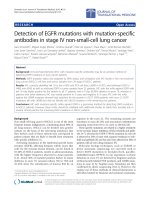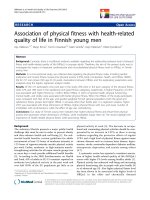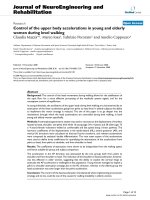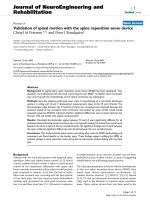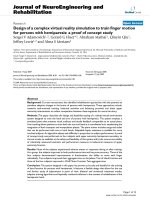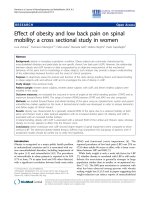Báo cáo hóa học: " Analysis of 22,655 presentations with back pain to Perth emergency departments over five years" pot
Bạn đang xem bản rút gọn của tài liệu. Xem và tải ngay bản đầy đủ của tài liệu tại đây (271.2 KB, 6 trang )
ORIGINAL RESEARCH Open Access
Analysis of 22,655 presentations with back pain
to Perth emergency departments over five years
Michael T Lovegrove
1,2*
, George A Jelinek
2,3
, Nicholas P Gibson
2
and Ian G Jacobs
2,3
Abstract
Background: Back pain is a significant cause of disability in the community, but the impact on Emergency
Departments (EDs) has not been formally studied. Patients with back pain often require significant time and
resources in the ED.
Aims: To examine the characteristics of patients presenting with back pain to the ED, including final diagnosis,
demographics of those attending and temporal distribution of presentations.
Methods: Emergency presentations in the metropolitan area of Perth, Western Australia, for 2000-2004 were
searched using a linked database covering all the major hospitals (Emergency Care Hospitalisation and Outcome
Study database). All pres entations with the triage code for back pain were extracted and analysed.
Results: A total of 22,655 presentations with back pain were identified, representing 1.9% of total presentati ons.
Simple muscular or non-sp ecific back pain accounted for only 43.8% of presentations, with other causes such as
renal colic and pyelonephr itis accounting for the majority. The young (<15 years old) and elderly (>75 years old)
were more likely to have non-muscular causes for their back pain. Muscular back pain presentations occurred
mostly between 0800 and 1600, with high proportions presenting on the weekends. Patients with simple muscular
back pain spent a mean of 4.4 h in the ED, representing a significant outlay of resources.
Conclusion: Back pain has a significant impact on EDs, and staff should be alert for another pathology presenting
as back pain. There is a need for multidisciplinary back pain teams to be available 7 days a week, but only during
the day.
Introduction
Back pain is a common problem and has a large effect on
work productivity, mental health and physical activities.
Approximately 80% of Australians suffer back pain at
some time, and two thirds have some form of back pain
in a 12-month period [1]. These findings are similar in
other regions [2-5]. Back pain places strain on the health
sys tem with as many as 50% of sufferers still having pro-
blems at 5 years [6]. If initial treat ment is effective, espe-
cially by a multidisciplinary team, then the recurrence
rate and long-term disability can be reduced [2,7-9].
Determining when these teams, which usually consist of
paramedical staff such as physiotherapists and occupa-
tional therapists, can be of the most use would assist in
resource allocation.
Onlyaminority(45%)ofthosewithbackpainseek
help [10]. About 10% have significa nt disability [1], and a
proportion of those present to the emergency department
(ED) for care. As with most emergency presentations, the
patient arrives with an undefined complaint that requires
diagnosis. Back pain can be relatively benign, but can
also be a symptom of more serious illness.
No large study looking at the pattern of ED back pain
presentations by adults or the range of diagnoses present-
ing as back pain to the ED has been published. One study
reported children presenting with back pain over a 1-year
period and identified 225 presentations, most due to
acute trauma, although infections such as urinary tract
infections and viral illnesses were also found [11].
Objective
The objective of this study was to identify patients pre-
senting to EDs in Perth, Western Australia, with back pain
and to characterise the pattern of their presentations.
* Correspondence:
1
Department of Emergency Medicine, Joondalup Health Campus, Shenton
Road, Joondalup, 6027, WA, Australia
Full list of author information is available at the end of the article
Lovegrove et al. International Journal of Emergency Medicine 2011, 4:59
/>© 2011 Lovegrove et al; licensee Springer. This is an Open Access article dist ributed under the terms of the Creative Commons
Attribution License ( which permits unrestricted use, distribution, and reproduction in
any medium, provided the original work is properly cited.
Hospital discharge and subsequent mortality were also
examined.
Methods
Data sources
The Emergency Care Hospitalisation and Outcome Study
(ECHO) database [12], which is a database that follows
patients through admission and subsequent presenta-
tions, was used.
The primary data were collected using EDIS (Emergency
Department Informat ion Systems, version 10.0, Health
Admini stration Solutions, Sydney), which contains infor-
mation on emergency presentations including patient
demographics, arrival and discharge dates and times, pre-
senti ng complaints, mode of arrival and triage score, and
disposition and discharge diagnosis from all of the metro-
politan EDs in Perth. Hospital admission data were
obtainedfromtheHospitalMorbidity Dataset. Death
records were obtained from t he Western Australian
Mortality Database.
Data analysis
EDIS records, hospital admission records and the Mortal-
ity Databa se were linked by the Weste rn Australian Data
Linkage Unit using probabilistic matching. Data analysis
was performed with the Statistical Package for the Social
Sciences (SPSS, version 12.0, Chicago, IL) and Microsoft
Excel for characteristics of patients, clinical problems,
mortality rates and departmental factors. To calculate
mortality rates, the last ED presentation of each patient
in the dataset elicited cumulative mortality figures at 2
and 30 days.
Back pain study
The ECHO database was searched for the period 1 July
2000 to 31 December 2004.
Presentations where the triage nurse selected the triage
code for “back pain” were extracted and analysed. This
cohort represents patients who, at the time of their first
assessment in the ED, indicated that back pain was the
most important reason for their presentation.
The patients’ age, sex, time of presentation (by day of
week and time of day), diagnosis (at discharge from the ED
and from hospital if admitted) and outcome of their time in
the hospital system, including admission, re-presentations
and mortality, were extracted. Data regarding their time in
the ED and treatment time (time from being s een by a doc-
tor to time of discharge) were also extracted.
This study group was then divided into two subgroups
based on the diagnosis made by the ED doctor. The first
group had a diagnosis consistent with non-specific pain
or muscular injury, with conditions likely to be benign.
The second group of patients consisted of those with
conditions likely to be “non-muscular” in nature such as
renal colic, pyelonephritis and pancreatitis. A decision
was made to include radicular pain and vertebral frac-
turesinthissecondgroupasthemanagementofthese
conditions is often different from simple soft tissue back
pain. The two groups were analysed and compared, look-
ing for significant differences in presentation or patient
characteristics.
Ethics approval
Ethical and record linkage approvals were granted by
the Human Research Ethics Committee at the University
of Western Australia and the Confidentiality of Health
Information Committee of Western Australia.
Results
A total of 1,171,713 presentations to Perth EDs were
recorded between the 1 July 2000 and 31 December
2004. Of these, 22,655 (1.9%) were coded with “ back
pain” as the primary complaint. Table 1 summarises the
results for all back pain presentations, the “ musc ular
group” and the “non-muscular” group.
The most common age group was between 35 and 44
(Figure 1). Females presented in significantly larger num-
bers in the older age groups (75 years and over) and also
in adolescence (15-24) (p < 0.005) (Figure 1).
Patients presented most often on Sundays with a gradual
decrease in presentations until Friday before increasing on
Saturday. A slightly disproportionately higher number of
presentatio ns occurred on weekends, wit h 30.2% of back
pain presentations occurring on Saturday and Sunday.
Presentations were most common between 0800 and
1400, accounting for 35.8% of total presentations, but
large numbers of presentations continued until midnight.
Relatively few patients (13.8%) presented between mid-
night and 0600 (Figure 2).
Overall, a quarter of patients (5,747, 25.4%) were
admitted, with females admitted more often than males
(27.2% vs. 23.4%, p < 0.005).
The majority of patients (88.9%) presented o nly once.
However 2,125 patients had multiple presentations, with
one individual presenting 104 times with back pain dur-
ing the data collection period. The mean number of pre-
sentations was 1.2 attendances, with 97% of patients
presenting only once or twice.
When presentations were analysed by cause, 43.8%
(9,926) were diagnosed as a muscular problem or non-spe-
cific back pain ("muscular” group). The remaining 56.2%
(12,729) were diagnosed as due to other medical and sur-
gical causes ("non-muscular” group). Of this group, 1,066
(8.4%) did not wait for treatment. “Did not wait” or similar
applied t o 610 of these at time of discharge with the
remaining 456 having a diagnosis made, but not waiting
for subsequent treatment. Males were significantly more
likely to not wait for treatment (p < 0.005).
Lovegrove et al. International Journal of Emergency Medicine 2011, 4:59
/>Page 2 of 6
“Muscular” group
Muscular causes of pain were relatively rare in children
under the age of 15 (2.0%).
Presentations for muscular pain occurred predomi-
nantly during the hours 0800-1400 (39.4% of presenta-
tions), with nearly 50% occurring in the 8 h between
0800 and 1600.
Only 17.1% of people in the “ muscular” group
required admission, but those admitted remained in
hospital an average of 6.4 days (SD 10.7 days). One per-
son was hospitalised for 163 days.
“Non-muscular” group results
In the “other” group, females represented 53% of the
12,729 presentations, significantly more than males (p <
0.005). The most common age groups remained the 25-34
and 35-44 groups, but the distribution of ages of those
presenting was more spread, with much high er numbers
in the 0-14 year a ge groups and 75+ age groups. Of 107
children below the age of 5 years who presented with back
pain, 99 (92.5%) had a diagnosis other than muscular, and
of those between the ages of 5 and 15 , 69. 1% (431 of 623
patients) were also in this group. Similarly, of those
patients over 75 years of age presenting with back pain,
60.4% (1,756 of 2,904) had causes that were found to be
non-muscular (Figure 3).
The admission rate for “ non-muscular” category was
31.8%, significantly more than that for musc ular causes
(p < 0.005). However, those who were admitted had a
mean length of stay of 5.8 days (SD 8.8 days), significantly
less than those admitted for muscular causes (p < 0.005).
The mean length of time spent in the ED was 5.1 h, 4.1
of these after b eing seen by the doctor. These times were
significantly longer than for patients in the muscular
group (p < 0.005).
There was significantly higher mortality at each time
point (in ED, 2 days and 30 days after presentat ion) than
for muscular back pain (p < 0.005).
The most common diagnoses made in the ED for
those people in the “non-muscular” group were:
Renal colic (9.7%)
Sciatica/radiculopathy (8.0%)
Urinary tract infection or pyelonephritis (6.4%)
No disease found (2.6%)
Hospital admissions
The most common hospital discharge diagnoses f or all
patients presenting with back pain who requi red admis-
sion were:
0
500
1000
1500
2000
2500
P
resentat
i
ons
Age group
F
M
Figure 1 Presentations by Gender and Age Group.
Table 1
All back pain Muscular Non-muscular
Total 22655 9,926 (43.8%) 12,729 (56.2%)
Female 51.4% 50% 53%*
Most common ages 35-44 years 35-44 and 25-34 years 35-44 and 25-34 years
Average age 46.3 46.6 46.2
Most common days presenting Sunday and Monday Sunday and Monday Sunday and Monday
% presenting on weekends 30.2% 30.3% 30.2%
Admitted 25.4% 17.1% 31.8%*
Admission LOS 6.0 days 6.4 days* 5.8 days
ED time 4.8 h 4.4 h 5.1 h*
Treatment time 3.6 h 3.1 h 4.1 h*
Death in ED 10 1 9*
Death within 48 h 30 4 26*
Death within 30 days 263 75 188*
*Significant.
0
500
1000
1500
2000
2500
3000
3500
Presentations
Time of da
y
Male
Female
Figure 2 Presentations by Gender and Time of Day.
Lovegrove et al. International Journal of Emergency Medicine 2011, 4:59
/>Page 3 of 6
Back pain (18.8%)
Renal colic (13.7%)
Lumbar sprain (11.1%)
Pyelonephritis or urinary tract infection (6.6%)
Vertebral crush fracture (3.6%)
Abdominal pain (2.3%)
Intervertebral disc prolapse (2.3%)
Pneumonia (1.5%)
Back pain was the presenting complaint in 47 cases of
angina and 24 cases of myocardial infarction. A total of
53 patients with pulmo nary emboli presented with back
pain, and 13 episodes of pancreatitis presented with
back pain as the primary complaint.
Seventeen cases of dissecting aortic aneurysms were
diagnosed in the ED in patients presenting with back
pain. Eighteen ruptured abdominal aortic an eurysms
(AAA) were diagnosed in the ED. There were five deaths
within 48 h of presentation from these 18 patients, with
3 in the ED.
Discussion
Size of problem
In our study, back pain in the ED was a large problem,
accounting for nearly 2% of attendances to the depart-
ments, each presentation requiring, on average, between
4.4 and 5.1 h of ED time. Average treat ment times after
seeing a doctor were between 3 and 4 h before dis-
charge occurred. This is despite nearly 83% of people
with simple muscular or non-specific back pain being
discharged home. Given the relatively low triage score
assigned to the patients presenting with muscular back
pain, a treatment tim e of less than an hour might be
anticipated; however the treatment time observed was
more than three times longer. Given the high rate of
discharge, this treatment time is likely to represent diffi-
culty i n achieving adequate analgesia and mobility. T he
duration of time spent in EDs for those admitted is ris-
ing with the increasing problem of access block.
The high rates of low back pain described, for all ages
in community surveys [11,13], but not seen in ED presen-
tations, supports the finding that the majority of patients
do not seek medical care for their pain [10].
Gender and age variation
Consistent with previous studies more females, and espe-
cially adolescent girls, show a greater incident of back pain
[3-5,10,11,13,14 ]. More elderly females presented with
back pain than men (1. 9 times more, age >75, 2.8 times
more >85). The increasing number of females living to
older age may account for this. Sixty percent of diagnoses
in this elderly group were of the “non-muscular” category.
Those at the extremes of age are also less likely to
have a simple muscular o r non-specific cause for their
pain. This was most marked in the youngest age group,
with more than 90% of those children aged 0-4 years of
age diagnosed with other causes for their back pain, but
the effect was clearly seen up to the age of 14, and also
in patients over the age of 75.
A significant number of children presenting with pain
in the back were found to have infective causes (viral ill-
nesses, urinary tract infections, meningitis, osteomyelitis),
although there was also a large number with torticollis or
wry neck that had been coded as neck/back pain by the
triage nurse. Even taking these into account, only 33 of
107 children aged 0-4 years of age had a muscular cause
for their pain, meaning that nearly 70% of young children
had non-muscular causes.
Time and day of week of presentations
A significant number of patients present with back pain,
particularly of a muscular or non-specific nature, on the
weekends. This has relevance to acute back pain services
where multidisciplinary back pain (MDBP) teams have
been set up to asses s and assist those with bac k pain.
There is good evidence that these services will generate a
quicker recovery of function [2,7-9], and our data suggest
it would be beneficial to run these 7 days a week. By pro-
viding cover between 0800 and 1600, 7 days a week,
49.2% of cases could be seen . If this was extended to
1800 at night, 58.2% would be seen, and if extended
through to midnight, 81.1% of cases could be seen
(Figure 4). If the service is provided only between 0800
and 1600 on w eekdays, then only 34.0% could be seen.
By extending this to 1800 on weekdays, 40.0% could be
seen, but even extending the service to midnight on
weekdays, only 56.1% of cases could be seen.
Patients presenting with back pain after hours are
more likely to be diagnosed with a non-muscular cause
for the pain. Common altern ate diagnoses were related
to the renal tract, particularly renal colic. This would
suggest that urinalysis, as a simple screening tool for
urinary pathology, should be considered when there is
doubt about the cause of back pain.
There was a surprisingly high mortality rate (1.2% 30
day mortality) for people presenting with back pain over-
all, and whilst most of this resulted from non-muscular
causes, there was a 30-day mortality of 0.8% even in
0
500
1000
1500
2000
2500
0
-4 years
15-24
…
35-44
…
55-64
…
75-84
…
P
resentat
i
on
s
Age group
Muscular
Other
Figure 3 Presentations by Category type and Age.
Lovegrove et al. International Journal of Emergency Medicine 2011, 4:59
/>Page 4 of 6
those with muscular or non-specific back pain. This may
reflect that the event of pain is a marker of o verall dete-
riorating function in some individuals, although this
study is not capa ble of determining these underlying
causes.
Ruptured abdominal aortic aneurysms and aortic dis-
sections were rare (0.08% and 0.09% of presentations,
respectively) when the initial complaint was one primar-
ily of back pain, but given their gravity, should be con-
sidered in all cases of back pain, particularly in the
elderly.
Limitations
As with any retrospective analysis, this study is limited
by the data e ntered by the treating doctors and nurses,
although some of the variables used are not subject to
data entry problems (including the patient demo-
graphics, presentation events and times). This study is
likely to underestimate the frequency of presentation to
ED with back pain as only patients with a triage code of
“Back Pain” were selected. It also did not include those
for whom back pain was present, but not considered the
most important of their complaints by the triage nurse.
The division of the overall cohort (into “muscular”
and “non-muscular” subgroups) was a relatively arbitrary
decision, but enabled us to highlight more serious
causes. A significantly larger number of people in the
“non-muscular ” category did not wait for trea tment or
left against advice, and this is likely to have p revented
full assessment and, thus, an accurate diagnosis.
Conclusion
This study has demonstrated that back pain as a pri-
mary complaint is a common problem in EDs, requiring
a significant amount of resources. The majority of
patients presenting with back pain had a cause other
than a simp le muscular pain or non-specific pain, and
these p resentations had a significant mortality. Patients
who are elderly (>75 years of age) or young (<14 years
of age) are more likely to have non-muscular causes for
their pain and should receive more careful evaluation to
look for serious pathology presenting as back pain.
This study also demonstrates a need for multidisci-
plinary teams managing muscular and non-specific back
pain to be available 7 days a week up until the early eve-
ning (e.g. 1800 hours) to provide the most efficient cov-
erage of people presenting with back pain of this type.
Education of staff or provision of analgesic and ther-
apy guidelines or flowcharts may be of use in speeding
up the management of muscular back pain in the ED.
Further studies looking at the efficacy of multidisci-
plinary back pain t eams in re duci ng subsequent pres en-
tations or long-term morbidity associated with muscular
back pain would be useful. A study looking at the causes
of mortality in those presenting with back pain would
also be of use in deter mining and treating preventable
causes.
Author details
1
Department of Emergency Medicine, Joondalup Health Campus, Shenton
Road, Joondalup, 6027, WA, Australia
2
Discipline of Emergency Medicine,
University of Western Australia, Nedlands, WA, Australia
3
Department of
Emergency Medicine, Sir Charles Gairdner Hospital, Nedlands, WA, Australia
Authors’ contributions
ML was involved in study design, data anaysis, statistical analysis and
manuscript preparation. GJ was involved in study design, data analysis and
manuscript preparation. IJ was involved in study design, data analysis and
manuscript preparation. NG was involved in study design, data extraction,
data analysis and statistical analysis. All authors read and approved the final
manuscript.
Authors’ information
Michael Lovegrove is an Emergency Specialist working in adult and
paediatric Emergency Departments in Perth, Western Australia.
Competing interests
The authors declare they have no competing interests
Received: 22 April 2010 Accepted: 17 September 2011
Published: 17 September 2011
References
1. Walker BF, Muller R, Grant WD: Low back pain in Australian adults:
prevalence and associated disability. J Manipulative Physiol Ther 2004,
27(4):238-44.
2. McKinnon MC, Vickers MR, Ruddock VM, Townsend J, Meade TW:
Community studies of the health service implications of low back pain.
Spine 1997, 22(18):2161-6.
3. Cassidy JD, Carroll LJ, Cote PL: The Saskatchewan health and back pain
survey. The prevalence of low back pain and related disability in
Saskatchewan adults. Spine 1998, 23(17):1860-6.
4. Gilgil E, Kacar C, Butun B, Tuncer T, Urhan S, Yildirim C, Sunbuloglu G,
Arikan V, Tekeoglu I, Oksuz MC, Dundar U: Prevalence of low back pain in
a developing urban setting. Spine 2005, 30(9):1093-8.
5. Oksuz E: Prevalence, risk factors, and preference-based health states of
low back pain in a Turkish population. Spine 2006, 31(25):E968-72.
6. Enthoven P, Skargren E, Oberg B: Clinical course in patients seeking
primary care for back or neck pain: a prospective 5-year follow-up of
outcome and health care consumption with subgroup analysis. Spine
2004, 29(21):2458-65.
0
0.1
0.2
0.3
0.4
0.5
0.6
0.7
0.8
0
.
9
0800-1600 0800-1800 0800-2000 0800-2200 0800-2400
Time of da
y
Proportion o
f
Muscular cases seen
Series1
Figure 4 Proportion of Muscular Back Pain seen by MDBP
teams by rostered hours over 7 days per week.
Lovegrove et al. International Journal of Emergency Medicine 2011, 4:59
/>Page 5 of 6
7. Guzman J, Esmail R, Karjalainen K, Malmivaara A, Irvin E, Bombadier C:
Multidisciplinary bio-psycho-social rehabilitation for chronic low back
pain. Cochrane Database Syst Rev 2002, 1.
8. Lang E, Liebig K, Kastner S, Neundorfer B, Heuschmann P: Multidisciplinary
rehabilitation versus usual care for chronic low back pain in the
community: effects on quality of life. Spine J 2003, 3(4):270-6.
9. Lau PM, Chow DH, Pope MH: Early physiotherapy intervention in an
Accident and Emergency Department reduces pain and improves
satisfaction for patients with acute low back pain: a randomised trial.
Aust J Physiother 2008, 54(4):243-9.
10. Walker BF, Muller R, Grant WD: Low back pain in Australian adults: health
provider utilization and care seeking. J Manipulative Physiol Ther 2004,
27(5):327-35.
11. Selbst SM, Lavelle JM, Soyupak SK, Markowitz RI: Back pain in children who
present to the emergency department. Clinical Pediatrics 1999,
38(7):401-6.
12. Sprivulis P, Da Silva J-A, Jacobs I, Jelinek GA, Swift R: ECHO: The
Emergency Care Hospitalisation and Outcome Linked Data Project. ANZ
J Public Health 2006, 30:123-127.
13. Gunzburg R, Balague F, Nordin M, Szpalski M, Duyck D, Bull D, Melot C:
Low back pain in a population of school children. Eur Spine J 1999,
8(6):439-43.
14. Watson KD, Papageorgiou AC, Jones GT, Taylor S, Symmons DPM,
Silman AJ, Macfarlane GJ: Low back pain in school children: occurrence
and characteristics. Pain 2002, 97(1-2):87-92.
doi:10.1186/1865-1380-4-59
Cite this article as: Lovegrove et al.: Analysis of 22,655 presentations
with back pain to Perth emergency departments over five years.
International Journal of Emergency Medicine 2011 4:59.
Submit your manuscript to a
journal and benefi t from:
7 Convenient online submission
7 Rigorous peer review
7 Immediate publication on acceptance
7 Open access: articles freely available online
7 High visibility within the fi eld
7 Retaining the copyright to your article
Submit your next manuscript at 7 springeropen.com
Lovegrove et al. International Journal of Emergency Medicine 2011, 4:59
/>Page 6 of 6
